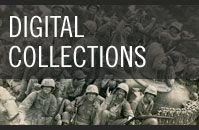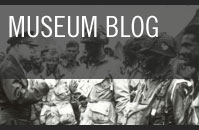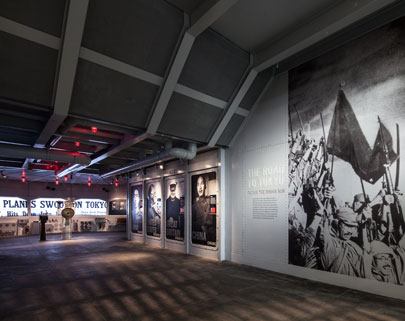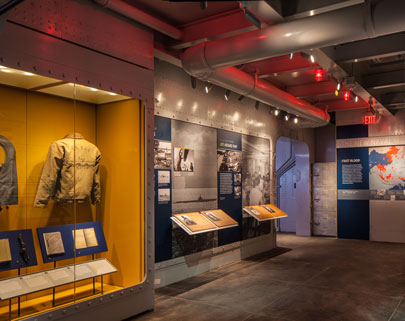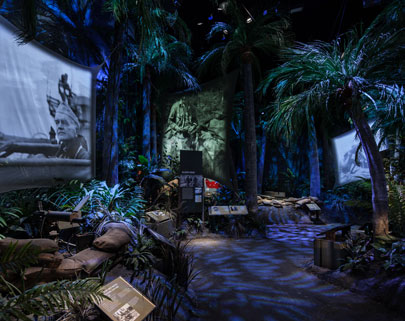MEDIA RESOURCES: ROAD TO TOKYO


Richard C. Adkerson & Freeport-McMoRan Foundation Road to Tokyo: Pacific Theater Galleries opens on the second floor of the Museum’s Campaigns of Courage pavilion on December 12, 2015. Ten galleries retrace the grueling trail that led from Pearl Harbor to Tokyo Bay by way of New Guinea and Southeast Asia, the Himalayas, Burma, the islands of the Pacific, China, India, and Alaska. Exhibits explore the evolving strategy for fighting relentless Japanese forces in Asia and the Pacific, examining cultural differences, logistical challenges, and the staggering range of extreme conditions that confronted American military forces in Asia and the Pacific.
Conveyed through artifacts, oral histories, serialized “Dog Tag” profiles, short films, and recreated environments, Road to Tokyo shares the narrative of a world that was unimaginably alien to American GIs, a conflict of searing brutality, and a victory so devastating it is hotly debated even today. This is the story of the Americans who forged a road to Tokyo through courage, ingenuity, and great sacrifice, and ended the war at last.

Click on an image below to download a high resolution file. Don’t see the image you are looking for? Contact us with your specific request. Please specify your publication and deadline.
Please credit all images "Courtesy of The National WWII Museum."

Road To Tokyo Images:
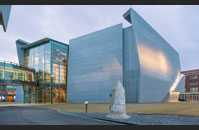
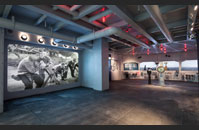
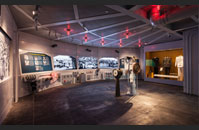
Campaigns exterior
Campaigns of Courage: European and Pacific Theaters, the newest pavilion on the campus of The National WWII Museum in New Orleans, opened December 13, 2014, with the dedication of its first-floor exhibition: Road to Berlin: European Theater Galleries. Road to Tokyo: Pacific Theater Galleries will open on the second floor in December 2015. |
|
The Road to Tokyo: Facing the Rising Sun
On the heels of the Japanese attack on Pearl Harbor, Germany and Italy have declared war on the United States. America is headed to war. Facing the Rising Sun takes visitors into this daunting moment in history, introducing the key leaders whose loyalties and ambitions define the moment, and the logistical challenges of a two-front war that will shape the years to come. |
|
Briefing Room: Japanese Onslaught
A recreated bridge of the USS Enterprise places visitors at the center of US strategy, aboard the carrier fleet that would be so critical to the success or failure of Allied efforts in the Pacific. Here, visitors take in an overview of US strategy and meet military leaders from both sides, while newsreels report Japanese victories and brutal treatment of American POWs. The Enterprise is steaming into hostile waters, and the odds for its survival—and the survival of the sailors, pilots, and mechanics on board—look grim indeed. |
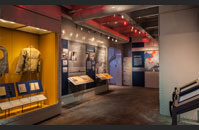
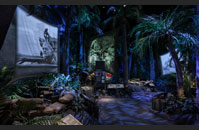
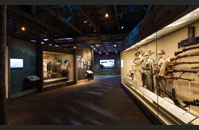
The New Naval Warfare: First Blood
In this two-part gallery, a ship's interior presents the quieter side of life aboard ship; "outside" on the ship's deck, story panels introduce key naval actions, and the Midway theater dives deeper into the Pacific’s most pivotal battle. Actual footage of planes in action on the Enterprise flight deck completes the illusion of being onboard ship as visitors take in themes of the new naval warfare, including submarine fatalities, code-breaking work, and the dramatic speed with which the tides of war can shift. |
|
Guadalcanal: Green Hell
The setting shifts from sea to land at Guadalcanal, the site of World War II’s first major amphibious landing and the first ground assault by US forces. Vividly rendered and viscerally impactful, this experiential gallery features an immersive environmental narrative that draws the visitor into a towering palm jungle, following in the footsteps of American servicemembers as they battled heat, mosquitoes, disease, dense vegetation, and unfamiliar terrain along with a ferocious enemy in an all-consuming, round-the-clock battle. |
|
Pacific Theater Challenges: Fighting in the Tropics
In addition to a merciless enemy, US troops in the Pacific Theater were faced with non-existent infrastructure and rampant disease. Under assault to body and mind, Americans needed superior engineering and ingenuity just to survive. This gallery tells the story of those who answered that call: Seabees who built roads and airfields; nurses and medics who treated new diseases with new vaccines; and chaplains who helped lift spirits wearied by the relentlessly brutal nature of the Pacific war. |
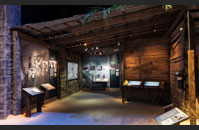
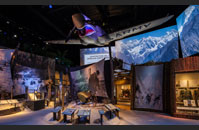
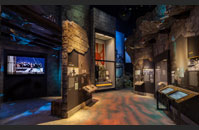
Island Hopping: Footholds across the Pacific
The “island hopping” strategy targeted key islands to capture and equip with airstrips, bringing B-29 bombers gradually within range of the enemy homeland. In this serpentine gallery, a realistic beachscape recreates a landing site on the island of Tarawa. Other exhibits describe the integrated effort between sea, land, and air, as well as successes in intelligence (Native American code talkers), technology (the long-range B-29 Bomber), and carrier warfare (the Marianas Turkey Shoot) in the fight for control of the skies. |
|
China-Burma-India: The Pacific War's Second Front
"CBI" held critical strategic importance for US forces: While 11 Japanese army divisions battled US forces on the islands and at sea, a staggering 40 more were tied up in the Sino-Japanese War in China—and the Allies were determined to keep them there. Doing so meant supplying the Chinese with essential materiel, overcoming a maze of logistical challenges. A contoured topographical map helps illustrate the geographical obstacles American troops faced as they defended supply lines, rescued downed pilots, and engaged in covert operations in support of this critical ally. |
|
Philippines: Returning to the Philippines
As an American Commonwealth, the Philippines held special meaning for US forces: this was American territory in enemy hands—and a people to whom the United States had promised independence. Its liberation, which MacArthur saw as a moral imperative, was a strategic necessity: the Philippines were perfectly positioned to control shipments oil and other supplies. The fight would be costly and vast. Manila, a city once known as “the pearl of the Orient,” was decimated by the conflict, resulting in the urban ruins depicted in this immersive gallery. |
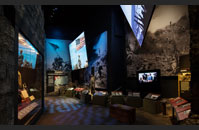
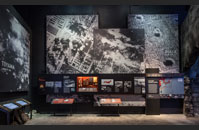
Death at Japan's Doorstep: First Assault onto Japanese Soil
Desperate fighting underscored the implacable fervor of the enemy—Japanese soldiers willing to resist to the last man. The enemy also had a logistical advantage: an underground defensive network of caves and tunnels, realistically depicted in this environmental gallery. Exhibits discuss the lifesaving impact of Navajo code talkers; the headline-grabbing losses of General Simon B. Buckner, journalist Ernie Pyle, and nearly 20,000 others; and the extraordinary valor that earned US Marines a total of 27 Medals of Honor in Iwo Jima—more than in any other battle in World War II. |
|
Downfall: Endgame Against Japan
This haunting gallery surrounds the visitor with scenes from the aftermath of the atomic bombs, presented on oversize screens and accompanied by a musical soundtrack that is both somber and contemplative—an invitation to reflect on a moment that has spurred debate ever since, and a moment when Japan at last saw the hopelessness of its cause. Visitors pass through to a final room in the gallery to witness the surrender ceremony aboard the USS Missouri, which marked, at last, an end to the war that changed the world. |
|
|

Road to Tokyo Artifacts:
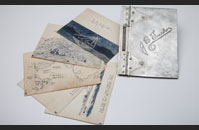
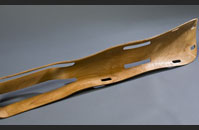
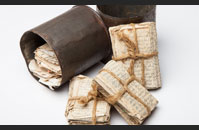
Diary of Jack B. Tucker
Jack Tucker enlisted in the Navy in 1942 at age 17, stationed on SC-505 (a “submarine chaser”) and later various submarines. His diary, including notes on his wartime experiences as well as sketches in his hand, features a unique cover made from aluminum salvaged from a downed Japanese plane. |
|
Eames Splint
In 1942, the US Navy commissioned husband-and-wife team Charles and Ray Eames to design this leg splint, which they modeled on Charles’s own leg. The Eameses used innovative technology to mold and shape lightweight plywood, replacing bulky and uncomfortable metal splints. They went on to use this technology in the manufacture of molded plywood stretchers and also glider components, and later for the renowned chairs that would make “Eames” a recognizable name in contemporary furniture design. |
|
Fred G. Oberman Canister Notes
During his years as a POW, Dutchman Fred G. Oberman risked his life to record details of the brutal treatment of prisoners, writing on scraps of paper that he bundled together and hid in a two-part canister. His notes told of the “Railway of Death” in Burma, where he along with thousands more were sent to work in slave labor gangs. Prisoners suffered malnourishment, brutal treatment, and disease, including typhoid, malaria, cholera, smallpox, dysentery, and tuberculosis. Thousands died in captivity. |
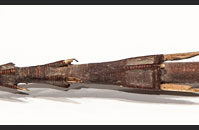

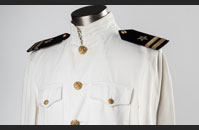
Jefferson DeBlanc Medal of Honor, Spear
When his aircraft ran critically low on fuel, First Lieutenant Jefferson J. DeBlanc first continued the fight as long as possible and then bailed out near the Solomon Islands. He swam to shore and spent three days surviving on coconuts before he was found by an indigenous tribe on the island of Vella Lavella. DeBlanc was traded to another tribe before finally being returned to Allied forces along with this spear—a souvenir of his adventures. President Truman awarded him the Medal of Honor on December 6, 1946, for his actions against the Japanese in the Solomon Islands. |
|
Submarine Key Ring
Once used by New Orleanian Herman “Dutch” Prager, this key ring would have equipped its holder for a multitude of tasks aboard ship. It consists of a brass snap hook on a split ring key ring with an adjustable wrench, four-bladed pocket knife (including a straight-blade screwdriver with bottle opener, a can opener, a pen-knife blade, and a large knife blade), a 1938 Australian penny, Prager’s dog tag, and three pairs of keys belonging to the submarine USS Kingfish. |
|
US Navy Service Dress White Uniform
The Service Dress White uniform was a sharp-looking, though somewhat impractical uniform. The coat’s traditional design, featuring a high, stiff collar and form-fitting cut, was reminiscent of 19th century officer’s dress. The tight collar also led to this uniform being known as the “choker.” This uniform was worn by Roland Broussard, who was commissioned in January 1943 and shipped to the Pacific Theater. He served as the gunnery officer aboard the USS Adhara (AK-71) and the US Army transport ATH-3. |
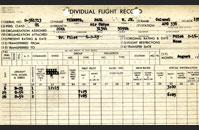
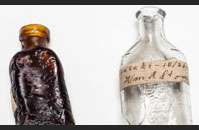
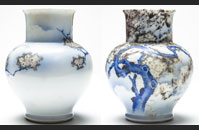
Flight Log
Paul Tibbets, the pilot of the bomber Enola Gay, recorded his missions in this flight log. His final mission in World War II was dropping “Little Boy”—the first atomic bomb—on the city of Hiroshima. Gift of Madlyn and Paul Hilliard, 2014.310.001. |
|
Glass Bottles
These glass bottles were taken from Nagasaki as a souvenir by William Ammon Stover on October 26, 1945. The glass bottles were warped by the heat of the atomic blast. Gift of The Family of William A. Stover, 2012.314.016-017. |
|
Vase
Recovered from Nagasaki by Lt. EL Willey, the Executive Officer of the USS Tills, this vase shows the effect of a flash burn from the atomic blast. The damaged side indicates that the vase would have been at the edge of the blast radius while the other side remained completely unharmed. Gift in Memory of Edward L. Willey, 2015.098. |
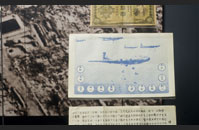
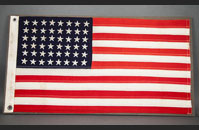
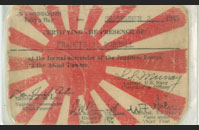
Leaflets
These leaflets, meant to warn Japanese civilians of impending firebombing and expose the weakness of the Japanese military to erode morale, were donated by Maurice Picheloup of the 39th bomb group. Picheloup took part in a night raid over Japan on August 14–15. Returning to base they received word of the end of the war. Gift of Maurice Picheloup, 2002.252.006. |
|
US Flag
On August 28, 1945, Robert Demorest Miller was part of a small advance party sent to Atsugi Air Base near Yokusuka to prepare for the beginning the occupation. Shortly after landing, he raised this flag on the radio mast of a C-47. It was recognized as the first American flag to fly over occupied Japan. Gift of Robert D. Miller, 2001.165.001. |
|
Surrender Card
Frank Borrell was a “plankowner” aboard the USS Missouri—part of the crew on June 11, 1944, when the “Mighty Mo” became the last battleship commissioned by the US Navy. Borrell was present at the formal surrender of the Japanese forces to the Allies and was given this commemorative card. Gift of Frank Borrell, 2010.485.013. |

Videos for Download:
NOTE: Videos may take several minutes to download depending on your browser and device.
Please credit all video "Courtesy of The National WWII Museum."
Road To Tokyo B-Roll

Museum Press Release and Fact Sheet:
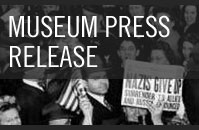
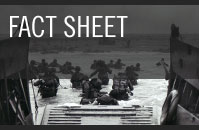

Additional Resources:
